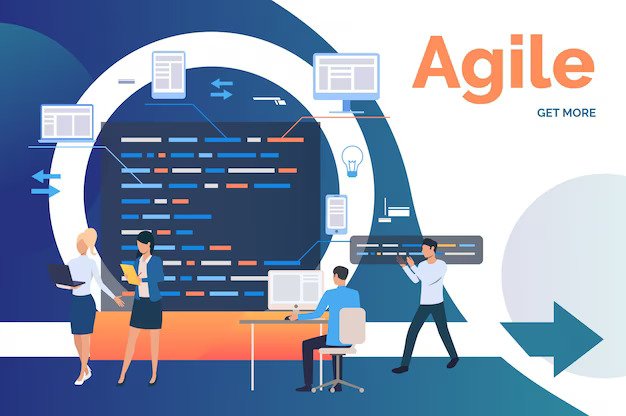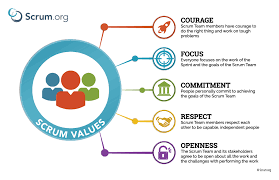SAFe Agile: Unleashing Agile Potential at the Enterprise Level

Introduction In a rapidly changing business landscape, organizations need to embrace agility to stay competitive. However, scaling agile practices beyond individual teams can pose significant challenges. This is where SAFe (Scaled Agile Framework) comes into play. SAFe Agile offers a comprehensive framework that enables enterprises to successfully implement and scale agile methodologies. In this blog post, we will explore the fundamentals of SAFe Agile, its core principles, and the key components that make it an invaluable asset for organizations embarking on large-scale agile transformations. 1. Understanding SAFe Agile SAFe Agile is a robust framework designed to help organizations implement agile practices across the enterprise. It provides a structured approach that allows multiple teams to work cohesively while ensuring alignment, collaboration, and efficient delivery of value. SAFe Agile extends the principles of agility beyond individual teams, enabling organizations to maintain adaptability and customer-centricity at scale. 2. Core Principles of SAFe Agile At the heart of SAFe Agile lie several core principles that drive its implementation: a) Lean-Agile Mindset: SAFe Agile emphasizes a continuous improvement mindset, lean thinking, and delivering value to customers. b) Systems Thinking: SAFe Agile promotes holistic thinking, recognizing the interconnectedness and dependencies among various components, teams, and stakeholders. c) Alignment: Aligning all teams and stakeholders towards a common mission and vision, SAFe Agile fosters collaboration, breaks down silos, and ensures synchronized efforts. d) Built-in Quality: SAFe Agile places a strong emphasis on maintaining high-quality standards throughout the entire development process, reducing defects and rework. e) Transparency: SAFe Agile encourages openness and transparency, facilitating effective communication, visibility, and shared understanding across all levels of the organization. f) Program Execution: SAFe Agile supports decentralized decision-making, fast feedback cycles, and iterative development through the implementation of Agile Release Trains (ARTs). 3. Key Components of SAFe Agile SAFe Agile encompasses several key components that work synergistically to enable enterprise-scale agility: a) Agile Release Train (ART): ART is the primary organizing construct in SAFe Agile, bringing together multiple teams aligned to a shared mission and working collaboratively to deliver value within fixed time increments called Program Increments (PIs). b) Program Increment (PI): PI represents a timebox lasting 8-12 weeks during which ARTs plan, execute, and deliver valuable features and functionalities. PI Planning is a crucial event where teams align their efforts, address dependencies, and establish a synchronized roadmap. c) Value Stream: SAFe Agile recognizes the importance of value streams, which encompass all the activities, processes, and stakeholders involved in delivering value to the customer. Mapping and optimizing the value stream ensure efficient value delivery. d) Agile Teams: SAFe Agile promotes the formation of self-organizing, cross-functional teams that work together to deliver value incrementally. These teams follow agile methodologies such as Scrum or Kanban and synchronize their efforts within the ART. e) Continuous Integration and Continuous Deployment (CI/CD): SAFe Agile encourages the adoption of DevOps practices, automated testing, and continuous integration to enable frequent and reliable integration, testing, and deployment of software. 4. Benefits of SAFe Agile Implementing SAFe Agile brings numerous advantages to organizations: a) Improved Collaboration and Alignment: SAFe Agile fosters collaboration, transparency, and shared objectives, resulting in improved alignment and coordination across teams and departments. b) Increased Productivity and Time to Market: By scaling agile practices, SAFe Agile enables faster delivery of high-quality products and services, reducing time to market and enhancing productivity. c) Enhanced Quality and Reduced Risk: SAFe Agile’s focus on built-in quality, iterative feedback loops, and continuous improvement leads to enhanced product quality, higher customer satisfaction, and reduced risk. d) Scalability and Flexibility: SAFe Agile provides a structured framework that allows organizations to scale their agile practices while maintaining adaptability and flexibility. e) Empowered and Engaged Teams: SAFe Agile empowers teams by providing clear roles and responsibilities, promoting autonomy, and fostering employee engagement and satisfaction. Conclusion SAFe Agile acts as a guiding light for organizations seeking to embrace agility at the enterprise level. By embracing SAFe Agile’s core principles and leveraging its key components, organizations can unlock the full potential of agile practices, driving collaboration, productivity, and success in a rapidly evolving business landscape.
Unleashing the Power of Scaled Agile: A Guide for Business Leaders

In today’s dynamic and fast-paced business landscape, staying ahead of the game is essential for success. As industries continue to be reshaped by technology, organizations must adapt and embrace innovative methodologies that foster efficiency, collaboration, and innovation. Enter Scaled Agile – a revolutionary approach that is rapidly gaining momentum across various sectors. In this blog post, we will explore the rise of Scaled Agile and why it is crucial for every business leader to understand its immense potential. Get ready to unlock the secrets behind this transformative methodology that promises unprecedented success for your organization! Demystifying Scaled Agile In recent years, the concept of Scaled Agile has garnered increasing interest. But what exactly is Scaled Agile? At its core, Scaled Agile is a methodology that enables organizations to successfully implement agile principles at scale. Clear communication and alignment across all levels of the organization, along with a focus on continuous improvement, are vital factors for the successful implementation of Scaled Agile. When executed correctly, it can enhance overall performance, efficiency, and cost-effectiveness for organizations. Moreover, it equips them with the agility to respond swiftly to market changes and customer demands. It is no surprise, then, that businesses of all sizes are embracing Scaled Agile. The Advantages of Scaled Agile Frameworks When it comes to software development, the Scaled Agile Framework (SAFe) has gained significant popularity. SAFe provides a set of guidelines and best practices for implementing agile methodologies within an enterprise. While traditional agile approaches like Scrum work well for small teams, they often struggle to scale up for large, complex projects. This is where SAFe shines. The benefits of using SAFe include: 1. Enhanced efficiency and productivity: By eliminating unnecessary steps and processes, SAFe enables teams to work more efficiently, resulting in increased productivity and faster delivery times. 2. Risk reduction: Following best practices for agile at scale reduces the risk of project failures within enterprises. 3. Improved quality: Applying SAFe throughout the software development process ensures the delivery of higher-quality products to customers. 4. Greater agility: SAFe empowers enterprises to be more agile in their approach to software development, enabling them to respond swiftly to market conditions and customer needs. 5. Better alignment: SAFe facilitates a common goal and alignment between teams, fostering improved communication and collaboration among team members. Providing Adequate Support for Teams Implementing Scaled Agile Practices To successfully implement scaled agile practices, it is crucial to provide teams with sufficient support. Establishing a robust and comprehensive support system is essential. This may involve offering training and development resources, as well as technical support staff to address any issues that arise. Creating a culture of collaboration and knowledge sharing is another vital aspect of ensuring teams have the necessary support during the implementation of scaled agile practices. By fostering an environment where team members feel comfortable sharing ideas and working together to solve problems, and ensuring information is easily accessible, organizations can empower their teams for success. Effective communication channels are also key to ensuring everyone understands what is happening and can provide feedback if needed. Formal channels, such as project management software, and informal channels, like team chat rooms or social media groups, contribute to a supportive environment for teams implementing scaled agile practices. Choosing the Right Model for Your Team’s Needs When it comes to scaled agile, there is no one-size-fits-all solution. The approach your team takes should align with the specific needs of your organization. Several models are available, each with its own advantages and disadvantages. The most critical consideration is selecting a model that suits your team’s needs. Here are a few popular options: 1. Scaled Agile Framework (SAFe): SAFe is a well-known scaling framework designed to help large organizations implement agile practices at scale. It integrates lean, product development flow, Kanban, and XP into a single framework. SAFe has been battle-tested in some of the world’s largest organizations, but it requires a significant commitment from all involved parties. 2. Large Scale Scrum (LeSS): LeSS is another popular scaling framework designed for large organizations. It integrates lean and XP into a simplified framework compared to SAFe. While LeSS may have fewer available resources than SAFe, its simplicity makes it easier to understand and implement. Real-World Examples of Successful Agile Transformations In the business world, success speaks for itself. Let’s explore some real-world examples of organizations that have achieved successful agile transformations: 1. ING Direct: By transitioning from a waterfall model to an agile one, ING Direct accelerated their time to market. This shift enabled them to introduce new features and products faster while increasing customer satisfaction. 2. Ford Motor Company: Ford adopted an agile development process for their SYNC 3 infotainment system and achieved impressive results. They delivered the system on time and within budget while improving quality and efficiency throughout the development process. 3. United Airlines: United Airlines embraced an agile development methodology and experienced significant improvements. Their website became more user-friendly, flights became more punctual, and overall customer satisfaction increased. These renowned organizations serve as inspiration for businesses aiming to transform their operations with agile methodologies. If they can do it, so can you! Key Considerations for a Smooth Transition When transitioning to Scaled Agile, several key factors must be considered. Firstly, ensure a clear understanding of your organization’s specific goals and objectives. Define the desired outcomes you aim to achieve through this transition. Secondly, gain buy-in and commitment from all levels within the organization. Top-down support is crucial for successful implementation. Lastly, establish well-defined processes and protocols to structure and distribute work across teams. These three pillars are essential for a smooth and successful transition. Common Pitfalls to Avoid While implementing scaled agile, it is important to avoid common pitfalls. Trying to do too much too soon is a common mistake. It is advisable to start small and gradually scale up the implementation. Another potential pitfall is not having the right people in place. Ensure that you have a strong team committed to the transition to scaled agile.
Scrum Alliance: Driving Agile Excellence and Fostering Collaboration

Introduction: In the fast-paced world of business, staying adaptable and nimble is crucial for success. Agile methodologies, particularly Scrum, have emerged as effective frameworks for managing projects in an iterative and collaborative manner. A key player in the agile landscape is the Scrum Alliance. This blog post delves into the significance of the Scrum Alliance in championing agile practices, facilitating knowledge transfer, and nurturing a strong community of agile practitioners. 1. Unleashing the Power of the Scrum Alliance Established in 2001, the Scrum Alliance is a non-profit organization that is committed to promoting and supporting Scrum’s principles and values. It serves as a global hub, connecting professionals, educators, and organizations seeking to embrace or enhance their agile practices. By offering an array of resources, certifications, events, and networking opportunities, the Scrum Alliance empowers individuals and teams throughout their agile journey. 2. Certifications for Agile Excellence A notable contribution of the Scrum Alliance lies in its comprehensive certification programs. These programs provide standardized training and recognition for individuals practicing Scrum. Popular certifications such as Certified ScrumMaster® (CSM®) and Certified Scrum Product Owner® (CSPO®) equip participants with essential knowledge, skills, and facilitation techniques necessary for effective leadership in Scrum teams. Moreover, the Scrum Alliance extends its certification offerings to advanced levels, including Certified Scrum Professional® (CSP®) and Certified Scrum Trainer® (CST®). These certifications enable agile professionals to elevate their expertise, contribute as mentors and trainers, and shape the future of the agile community. By obtaining these certifications, practitioners not only validate their skills but also demonstrate their commitment to continuous growth and professional development. 3. Collaborative Events and Engagements The Scrum Alliance actively promotes collaboration and knowledge sharing through a diverse range of events and engagements. The globally renowned Global Scrum Gathering® stands as a pinnacle event where agile practitioners from across the globe converge to learn, exchange experiences, and establish connections. With captivating keynote speeches, interactive workshops, and open spaces for discussion, participants gain insights from industry thought leaders and forge invaluable relationships. In addition to the flagship gathering, the Scrum Alliance extends its support to regional and local events, including user group meetings, meetups, and conferences. These events serve as platforms for agile enthusiasts to explore real-world case studies, learn from seasoned practitioners, and build robust networks within their local agile communities. 4. A Thriving Community of Agile Practitioners At its core, the Scrum Alliance thrives on the strength of its passionate and tightly-knit community of agile practitioners. Through online forums, discussion groups, and collaborative platforms, the alliance fosters an environment of knowledge exchange, problem-solving, and peer support. Members gain access to a vast network of professionals eager to share best practices, provide guidance, and facilitate growth. Furthermore, the Scrum Alliance nurtures a culture of mentorship and coaching within its community. Experienced agile professionals readily step forward as mentors, offering valuable guidance and support to those new to Scrum or seeking to refine their skills. This mentorship ethos not only strengthens individual capabilities but also fosters a sense of camaraderie and collaboration among agile practitioners. Conclusion The Scrum Alliance serves as a catalyst for the advancement and widespread adoption of Scrum principles and practices. Through its certification programs, collaborative events, and thriving community, the alliance empowers agile practitioners, supports their professional journeys, and fuels collaboration. By facilitating knowledge sharing and networking, the Scrum Alliance propels the growth of agile methodologies, empowering organizations to thrive amidst ever-evolving business landscapes. Whether you are an agile beginner or an experienced practitioner, joining the Scrum Alliance offers a gateway to an expansive network and a wealth of resources to guide and elevate your agile endeavors.
Agile Alliance: Driving Organizational Agility and Success

Introduction In today’s rapidly evolving business landscape, organizations across industries face the challenge of adapting to constant change. Traditional rigid methodologies no longer suffice, prompting the need for a more flexible and dynamic approach. Enter Agile Alliance, a global nonprofit organization at the forefront of advocating and advancing Agile practices. In this blog post, we will delve into the key concepts, benefits, and impact of Agile Alliance in driving organizational agility and success. What is Agile Alliance? Agile Alliance is a collaborative community of professionals dedicated to promoting Agile principles and practices worldwide. Founded in 2001, the organization serves as a platform for fostering knowledge sharing, providing resources, and facilitating dialogue among Agile enthusiasts, practitioners, and thought leaders. Agile Alliance aims to support individuals and organizations in adopting Agile methodologies to respond effectively to market dynamics and customer needs. The Core Principles of Agile At the heart of Agile Alliance’s mission lie the core principles of Agile methodology. Agile approaches emphasize iterative development, continuous feedback, and adaptability. Rather than following a linear project management approach, Agile embraces flexibility and collaboration. Key principles include valuing individuals and interactions over processes and tools, delivering working software frequently, fostering customer collaboration, and responding to change promptly. Promoting Collaboration and Knowledge Sharing Agile Alliance plays a vital role in fostering collaboration and knowledge sharing within the Agile community. The organization hosts the renowned Agile conference, a flagship event that brings together industry experts, practitioners, and newcomers to exchange ideas, share experiences, and learn from one another. Additionally, Agile Alliance publishes articles, whitepapers, and case studies, offering a wealth of resources to guide organizations in their Agile journey. Enabling Agile Education and Training To support the widespread adoption of Agile practices, Agile Alliance invests in education and training initiatives. The organization offers certification programs, workshops, and webinars to equip professionals with the necessary skills and knowledge to implement Agile methodologies successfully. By providing accessible and quality educational resources, Agile Alliance empowers individuals and teams to embrace Agile principles and achieve better outcomes. Driving Organizational Agility Agile Alliance plays a crucial role in driving organizational agility, enabling companies to respond swiftly to market changes, customer feedback, and emerging opportunities. By implementing Agile practices, organizations can improve project visibility, enhance collaboration, and deliver value incrementally. Agile methods such as Scrum and Kanban enable teams to adapt quickly, optimize productivity, and ensure continuous improvement, resulting in faster time-to-market and increased customer satisfaction. Benefits of Agile Adoption The benefits of Agile adoption are manifold. Agile methodologies promote transparency, reducing project risks and increasing stakeholder engagement. By fostering collaboration, Agile enables cross-functional teams to work together effectively, harnessing collective intelligence and creativity. Agile practices also encourage a customer-centric approach, ensuring that development efforts align closely with customer needs, resulting in higher-quality products and services. The Impact of Agile Alliance Over the years, Agile Alliance has had a significant impact on the software development industry and beyond. By advocating Agile principles and methodologies, the organization has sparked a global shift in mindset and approach to project management. Agile Alliance has played a crucial role in fostering innovation, enhancing product delivery processes, and improving overall organizational performance. Its efforts have contributed to the success of numerous companies and have influenced the evolution of Agile practices worldwide. Conclusion Agile Alliance continues to be a driving force behind the adoption and advancement of Agile methodologies. Through its collaborative community, educational initiatives, and knowledge sharing platforms, the organization empowers individuals and organizations to embrace Agile principles, driving organizational agility and success. In a rapidly changing world, Agile Alliance serves as a guiding light, helping businesses navigate uncertainty, enhance collaboration, and achieve better outcomes through Agile practices.
Agile Coaching: Empowering Teams for Success in a Dynamic World

Introduction: The realm of software development and project management is marked by rapid changes and constant evolution. In this landscape, Agile coaching have emerged as a game-changer, offering adaptive planning, evolutionary development, early delivery, and continuous improvement. Agile empowers teams to respond swiftly to customer needs and deliver top-quality products. However, Agile adoption requires more than a one-size-fits-all approach. It demands a transformative shift in mindset, culture, and work processes. This is where Agile coaching comes in – a vital role that guides organizations and teams on their Agile journey, fostering collaboration and nurturing high-performing teams. What is Agile Coaching? Agile coaching is a collaborative and iterative approach that facilitates the implementation of Agile principles and practices within an organization or team. An Agile coach acts as a mentor, facilitator, and catalyst for change, guiding teams through their Agile transformation journey. These professionals possess in-depth knowledge of Agile methodologies, diverse domain experience, and exceptional communication skills. Agile coaching is not about enforcing rigid rules; it’s about empowering teams to discover the best Agile practices that align with their unique challenges and objectives. The Role of an Agile Coach: Benefits of Agile Coaching: Conclusion: Agile methodologies have proven to be transformative in the world of software development. However, successful Agile adoption requires more than just following prescribed practices. It necessitates a cultural and mindset shift. Agile coaching plays a pivotal role in guiding organizations and teams through this transformational journey. By creating awareness, empowering teams, removing roadblocks, and fostering collaboration, Agile coaches enable the creation of high-performing teams that consistently deliver value. With their expertise and guidance, organizations can unlock the full potential of Agile and achieve sustainable success in today’s dynamic and competitive landscape.
How to Use DevOps and Scrum to Improve Software Delivery

Introduction : In the fast-paced world of software development, organizations are constantly seeking ways to enhance their software delivery process. Two popular methodologies that have gained significant attention are DevOps and Scrum. DevOps focuses on improving collaboration and integration between development and operations teams, while Scrum offers a framework for agile project management. Combining these two approaches can lead to more efficient and effective software delivery. In this blog post, we will explore how to leverage the power of DevOps and Scrum to optimize your software delivery process, resulting in improved productivity, quality, and customer satisfaction. Section 1: Understanding DevOps To begin, let’s delve into the concept of DevOps and its key principles. DevOps emphasizes the integration of development and operations, aiming to break down silos and create a culture of collaboration and shared responsibility. By promoting continuous integration, automated testing, and continuous delivery, DevOps fosters faster development cycles and ensures higher-quality software. Continuous integration allows developers to frequently merge their code changes into a central repository, enabling early detection of integration issues. Automated testing ensures that software changes are thoroughly tested, reducing the risk of defects and improving overall software quality. Continuous delivery allows for rapid and reliable software releases, enabling organizations to quickly respond to customer needs and market demands. Additionally, DevOps encourages the use of infrastructure as code (IaC) and deployment automation, enabling more consistent and reliable software releases. With IaC, infrastructure configurations are defined in code, making it easier to manage and replicate infrastructure environments. Section 2: Unveiling Scrum Now, let’s explore Scrum, an agile project management framework that helps teams deliver software iteratively and incrementally. Scrum operates through short, time-boxed iterations called sprints, during which teams plan, develop, test, and deliver valuable increments of the software. The Scrum framework comprises various roles, such as the Product Owner, Scrum Master, and Development Team, all working together to maximize transparency, inspection, and adaptation. Scrum provides a structured approach to managing software development projects, fostering flexibility, and enabling teams to quickly respond to changing requirements. Through the use of user stories, the Product Owner defines the desired functionalities from the user’s perspective. The Development Team collaborates to estimate, plan, and implement these user stories within the sprint. The Scrum Master ensures that the team adheres to the Scrum principles and facilitates the removal of any impediments that may hinder progress. Regular ceremonies, such as daily stand-up meetings, sprint planning, sprint reviews, and retrospectives, promote transparency, feedback, and continuous improvement. Section 3: Leveraging the Synergy When DevOps and Scrum are combined, their strengths complement each other, creating a powerful synergy that can revolutionize software delivery. Here are some key strategies for leveraging this synergy: 1. Collaboration and Communication: DevOps and Scrum both emphasize collaboration and effective communication. Encourage cross-functional teams to work closely together, facilitating seamless knowledge sharing and continuous feedback. Regular stand-up meetings, sprint reviews, and retrospectives promote transparency and foster a culture of continuous improvement. By bringing development, operations, and other stakeholders together, organizations can address issues and make informed decisions collaboratively. 2. Automation and Continuous Integration: DevOps encourages automation throughout the software development lifecycle, and Scrum emphasizes continuous integration. By automating processes such as code integration, testing, and deployment, you can ensure faster and more reliable software delivery. Tools like Jenkins, GitLab, and Docker can assist in automating these processes. Automated testing can be integrated into the CI/CD pipeline to provide quick feedback on the quality of software changes. This automation helps reduce errors, shorten feedback loops, and enables more frequent releases. 3. Infrastructure as Code (IaC): Adopting infrastructure as code practices allows you to manage your infrastructure through version-controlled code, enabling consistency and reproducibility. This aligns with DevOps principles and supports the iterative and incremental nature of Scrum. Infrastructure automation tools like Terraform and Ansible can be utilized to define and manage your infrastructure as code. By treating infrastructure configurations as code, organizations can ensure that infrastructure changes are tested, versioned, and deployed consistently alongside software changes, reducing the risk of configuration drift and improving overall system stability. 4. Continuous Improvement: Continuous improvement is at the heart of both DevOps and Scrum. Encourage regular retrospectives at the end of each sprint to reflect on what went well and identify areas for improvement. Use the insights gained from retrospectives to refine your processes, enhance collaboration, and optimize your software delivery pipeline. Consider implementing metrics and monitoring systems to gain visibility into the performance of your software delivery process. By measuring key metrics like lead time, deployment frequency, and mean time to recover, organizations can identify bottlenecks and continuously refine their practices. Conclusion: DevOps and Scrum offer complementary approaches to improving software delivery. By embracing DevOps principles such as collaboration, automation, and continuous integration, while leveraging the iterative and adaptive nature of Scrum, organizations can achieve faster, more reliable software releases. Remember to foster effective communication, automate processes, adopt infrastructure as code practices, and promote a culture of continuous improvement. By combining the strengths of DevOps and Scrum, you can transform your software delivery process, enhance productivity, deliver high-quality software, and increase customer satisfaction.
Unleashing the Power of Agile Metrics: Driving Success through Data-Driven Insights

Introduction In today’s fast-paced and competitive business world, organizations are constantly on the lookout for ways to optimize processes, boost productivity, and deliver exceptional value to customers. Agile metrics step up to the plate, providing essential insights into Agile team performance and progress. They empower organizations to make informed decisions, track project health, and foster continuous improvement. In this blog, we embark on a journey into the realm of Agile metrics, understanding their significance, exploring different types, and appreciating their pivotal role in driving successful Agile implementations. The Essence of Agile Metrics: Agile metrics act as guiding stars for organizations navigating the Agile landscape. They enable teams to measure and assess various aspects of their projects, unveiling bottlenecks, spotting opportunities for growth, and enabling data-driven decisions. By quantifying performance and progress, Agile metrics fuel teams to proactively tackle challenges, enhance collaboration, and optimize project outcomes. Exploring Agile Metric Types 1. Velocity: The velocity metric measures the amount of work an Agile team completes during a sprint. It provides crucial insights into team productivity and aids in predicting future performance using historical data. 2. Cycle Time: Cycle Time represents the duration taken to complete a user story, from inception to delivery. By tracking cycle time, teams can identify process inefficiencies, streamline workflows, and reduce lead times, resulting in faster deliveries and heightened customer satisfaction. 3. Burnup and Burndown Charts: These visual tools display the progress of work over time. Burnup charts showcase completed work against total planned or remaining work, managing scope and promoting effective communication within the team and stakeholders. 4. Defect Density: This metric measures the number of defects identified per unit of work, such as lines of code or user stories. Monitoring defect density empowers teams to gauge the quality of their deliverables, identify patterns, and implement preventive measures to minimize defects in future iterations. 5. Customer Satisfaction: Metrics like Net Promoter Score (NPS) or customer feedback ratings gauge customer satisfaction levels. Continuously monitoring customer satisfaction aligns Agile teams with customer needs, enables product feature enhancements, and cultivates customer loyalty. 6. Team Happiness: Happy teams are productive and collaborative teams. Metrics like team morale surveys or employee engagement scores offer insights into the team’s well-being, facilitating a positive work environment and nurturing team satisfaction. Driving Success through Agile Metrics Agile metrics are a catalyst for success in various ways. They foster transparency, granting stakeholders a clear understanding of project progress, risks, and opportunities. With this visibility, management can make informed decisions and adapt strategies as needed. Furthermore, Agile metrics fuel continuous improvement. By analyzing performance data, teams identify areas for improvement, implement process refinements, and strive for higher efficiency and productivity. Optimized sprint planning, reduced cycle time, and enhanced team collaboration become achievable goals. Lastly, Agile metrics promote accountability. Access to objective performance data motivates teams to take ownership of their work, pursue excellence, and honor their commitments. Conclusion Agile metrics hold the key to unlocking the full potential of Agile methodologies. By measuring various aspects of the Agile process, teams gain invaluable data-driven insights, paving the way for continuous improvement and project success. Whether it’s monitoring velocity, visualizing progress through burnup charts, or prioritizing customer satisfaction, Agile metrics serve as invaluable allies in the pursuit of excellence.
Unveiling Kanban: Empowering Agile Workflow Management

Introduction In the dynamic realm of modern business, organizations are perpetually in pursuit of efficient workflow management solutions. One such popular approach that has gained significant traction is Kanban. Initially developed by Toyota as a lean manufacturing method, Kanban has transformed into a versatile framework applicable across various industries. This blog post delves into the core principles of Kanban, its genesis, and how it can revolutionize the way teams handle their work processes. 1. Unearthing the Genesis and Essential Tenets of Kanban Kanban, derived from the Japanese terms for “visual signal” or “card,” was first introduced by Toyota in the 1940s as a scheduling system for manufacturing processes. Its purpose was to optimize production by minimizing waste and ensuring a seamless workflow. At the heart of Kanban lies the concept of visually representing work items using cards or signals. In the Kanban framework, each work item finds its manifestation on a Kanban board, typically comprised of columns representing distinct workflow stages. This visual aid enables teams to have a clear overview of their work, identify bottlenecks, and maintain a consistent flow of tasks. The work items are represented by cards that progress across the board, moving from one column to the next as they advance. 2. Key Principles Guiding Kanban Kanban operates on a set of fundamental principles: a) Visualizing the Workflow: The primary principle of Kanban is to visualize the workflow. By providing a transparent representation of the work process, teams gain insights into the status of each task, identify dependencies, and track progress effortlessly. b) Limiting Work in Progress (WIP): Kanban places great emphasis on limiting the number of ongoing work items at any given time. This constraint prevents overburdening and ensures that teams focus on completing tasks before commencing new ones. By minimizing multitasking, teams can enhance efficiency and reduce lead times. c) Managing Flow: Maintaining a smooth and continuous flow of work items lies at the core of Kanban. Teams strive to minimize waiting periods, overcome bottlenecks, and mitigate disruptions, thereby optimizing productivity and diminishing cycle times. d) Explicit Policies: Kanban encourages teams to establish explicit policies governing their work processes. These policies outline rules and guidelines for each stage of the workflow, fostering consistency and clarity among team members. 3. Benefits Unleashed by Kanban Organizations implementing Kanban can reap several benefits: a) Augmented Visibility: Kanban provides real-time visibility into the status of work items, enabling team members and stakeholders to track progress, identify obstacles, and make informed decisions effortlessly. b) Enhanced Efficiency: By imposing limits on work in progress, Kanban enables teams to concentrate on completing tasks instead of initiating new ones. This focus amplifies productivity, reduces context switching, and enhances overall efficiency. c) Increased Flexibility: Kanban exhibits remarkable adaptability, making it suitable for diverse industries and workflows. Its flexible nature empowers teams to tailor the framework to their specific needs, rendering it viable for both small teams and large organizations. d) Continuous Improvement: Kanban fosters a culture of continuous improvement. By regularly scrutinizing the flow of work, teams can identify areas for optimization, experiment with process alterations, and continually refine their workflows. Conclusion Kanban offers a potent framework for managing workflows in a visual, efficient, and adaptable manner. By visualizing work, limiting work in progress, managing flow, and establishing explicit policies, teams can streamline their processes and achieve elevated levels of productivity. Whether in software development, project management, or any other industry, Kanban empowers organizations to optimize their workflows, minimize waste, and deliver value to customers with greater efficacy. Embracing Kanban marks a pivotal step toward adopting an agile and responsive approach to work, enabling teams to thrive in today’s ever-evolving business landscape.
Choosing the Right Path: Comparing Waterfall and Agile Product Development

Introduction In the world of software development, there are two main project management methodologies: waterfall and agile. Both methodologies have their own strengths and weaknesses, and the best approach for a particular project will depend on a number of factors, such as the size and complexity of the project, the level of uncertainty involved, and the needs of the stakeholders. Waterfall Methodology The waterfall methodology is a linear, sequential approach to project management. Each phase of the project must be completed before the next phase can begin. This approach is well-suited for projects where the requirements are well-defined and there is little uncertainty. The waterfall methodology can be broken down into the following phases: Agile Methodology The agile methodology is an iterative, incremental approach to project management. The project is broken down into small, manageable chunks, and each chunk is developed and delivered in a short sprint. This approach is well-suited for projects where the requirements are not well-defined or where there is a high level of uncertainty. The agile methodology can be broken down into the following phases: Comparison of Waterfall and Agile The following table compares the waterfall and agile methodologies on a number of dimensions: Dimension Waterfall Agile Planning Extensive upfront planning Less planning, more focus on iteration and adaptation Communication Communication is primarily between stakeholders and project manager Communication is more fluid and occurs throughout the project Risk management Risks are identified and managed early in the project Risks are identified and managed throughout the project Change management Changes are difficult to make once the project has started Changes are easier to make because the project is broken down into smaller chunks Documentation Extensive documentation is created Less documentation is created Testing Testing is done at the end of the project Testing is done throughout the project Deployment Deployment is done at the end of the project Deployment can happen multiple times throughout the project Which Methodology is Right for You? The best approach for a particular project will depend on a number of factors, such as the size and complexity of the project, the level of uncertainty involved, and the needs of the stakeholders. If the project is large and complex, with well-defined requirements, then the waterfall methodology may be a good fit. If the project is small and simple, with less well-defined requirements, then the agile methodology may be a better fit. Ultimately, the best way to decide which methodology is right for you is to consider the specific needs of your project. Conclusion The waterfall and agile methodologies are two of the most popular project management methodologies in software development. Both methodologies have their own strengths and weaknesses, and the best approach for a particular project will depend on a number of factors.
Scrum Values

Welcome to Scrum Sutra — a series where I shall share a 3-min overview of each element of Scrum and how it connects with the other elements in the bead to form Scrum Sutra. Today, I shall talk about Scrum Values. “Successful use of Scrum depends on people becoming proficient in living five values.” — Scrum Guide 2020 Scrum as a framework has no prescribed rule for every interaction and collaboration within and outside the Scrum Team. It is intentionally done to allow individuals and teams to make their own decisions on how they would like to have their interactions, and processes to achieve higher productivity and better value delivery. In order to help the Scrum Team and Stakeholders make that effective decision, the Scrum Guide provides a set of values on which Scrum is based. The Scrum Team and Stakeholders become proficient when they use the Scrum values for every decision they make. And then subject those decisions to empiricism — apply those experimentally, observe the results and draw conclusions. “When your values are clear to you, making decisions becomes easier.” — Roy Disney A great Scrum Team puts every action and decision of theirs to a litmus test: “Will this action move us closer to honoring our Scrum values or further away?” “If we make this decision, will we still be living the Scrum values?” A decision based on the Values may not be the easiest or the most enjoyable at that moment. But that discomfort will pass and what will remain is the internal feeling of rightness for a more fulfilling decision. On the contrary, a decision made based on what is easier now, which will maintain status-quo will leave the team feel tensed. Hence, the Scrum Team need to be courageous to make decisions according to values. “The bitterness of poor quality remains long after the sweetness of low price is forgotten.” — Benjamin Franklin What values the Scrum Team honor show up in the choices they make in their day-to-day interaction and those choices are visible in the behavior they demonstrate. Just walk past a Daily Scrum and you will notice the values they honor just by observing their behavior. As an example, you will see Developers being Respectful to each other’s inputs, being Open to demonstrate progress, Open to feedback, Open to ask for, and offer help, Open to inspect and adapt Sprint Plan toward the Sprint Goal, to be Courageous to hold each other accountable and to discuss impediments. All this to ensure their Commitment and Focus on the Sprint Goal. Sprint Retrospective is a formal opportunity for the Scrum Team to look back over their various interactions and the decisions they’ve made and see where the Scrum values were honored or were ignored. As a Scrum Master this information is very valuable to you for value clarification and to help the team see an elephant in the room. There is no specific order for Scrum Values, rather they form a constellation. So, while each Scrum Value has its own unique tone, when played together they create a unique harmony. When a Scrum Team and Stakeholders do not maintain that symphony, the discord can get so disturbing that it can become toxic. An increase in proficiency in living the Scrum values allows for more effective events, more useful artifacts and accountabilities acted out more productively. All these factors foster trust, empirical process control and make the Scrum Team maximize value, reduce waste and manage risk. That’s a 3-min overview on Scrum Values. Stay tuned to the next in the Scrum Sutra series.
Crafting a good Sprint Goal

The Sprint Goal is a manifestation of Habit — 2 “Begin with End in Mind” in a much inspiring book “The 7 Habits Of Highly Effective People” by Stephen Covey
Scrum – Empiricism

There exists no “correct” way of working on a complex situation. Hence the entire process should be a series of controlled experiments and data-driven decisions aiming towards the overarching goal.


